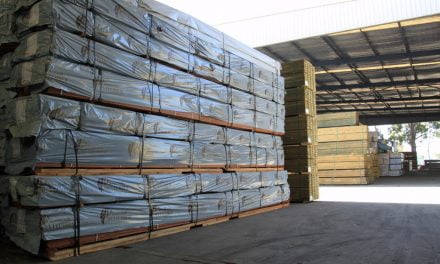Monthly updates from top industry identities
THIS MONTH’S TALKIN’ TIMBER IS WITH Bruce Hutchings, Director of Timberbuilt Solutions
To paraphrase the Prime Minister, “there has never been a more exciting time to be an Australian” timber engineer. In the past 30 plus years that my business, Timberbuilt has been engaged with designing and prefabricating commercial scale timber structures, there has not been a time when there has been such a confluence of factors as positive for the use of structural timber systems in place of steel and concrete as is now the situation.
Increasing community awareness of the environmental advantages of timber is being reflected by widespread interest in timber structural systems by architects and developers.
Recent changes in the BCA, facilitating the use of timber systems for structures up to 25 m in height provides even further opportunity. At the same time, builders are showing increased interest in exploring the potential of timber as a means to improve productivity in construction. Whilst these factors also provide considerable opportunities for the truss and frame sector, the following discussion will focus on ‘mass timber’ or ‘heavy section’ timber systems.
The availability of CLT as a new timber product and its presentation as a fully prefabricated system, supplied ready for site installation, has captured the interest of builders. Builders, Lendlease and Strongbuild are demonstrating their convictions by making significant investments for prefabrication manufacture. The announcement by Xlam of their plans for establishment of a CLT manufacturing facility is further evidence that this looming opportunity will not be a “false dawn”.
It is also likely that with the evolving interest in timber there will be extended opportunity for the not-so-new materials such as LVL and glulam to provide large section beams and columns both in conjunction with CLT as a panel product and for stand-alone beam and column arrangements. Opportunities are likely to emerge for the development of new LVL derivative products for floors. If this market development does catch on, there is likely to be a pressing need and the opportunity for industrialisation of glulam manufacture in Australia to give the economies of scale evident for glulam manufacture in Europe and North America.
Whilst the expansion of opportunity for timber for multi-level buildings has captured much attention, innovation in rigid frame jointing options that benefit the efficiency of installation of portal frames also provide further opportunity for the use of LVL and glulam for construction for low rise warehouse and factory buildings. These types of buildings certainly remain of great interest to Timberbuilt and hopefully some of the entities establishing new manufacturing facilities will see fit to construct their buildings in timber!
Underpinning the commercial application of the new timber technologies is the use of 3D software modelling and CAD/CAM manufacture of components to high levels of precision ready for site assembly. Comprehensively prefabricated timber systems, precisely detailed and manufactured to match the as-built intersections with other structural elements and with BIM interoperability employed for design of services layout, façade installations, etc, offers the potential for substantial construction efficiency, productivity and safety dividends. I say potential, because these technologies do not in themselves guarantee the desired outcome; persons utilising such software need to be able to relate the virtual model to the real world to be effective. These software products are simply ‘tools’ to be applied to advantage.
There will be challenges for both the construction and the timber industries. The current “design, bid and build” process for the construction industry does not accommodate the current situation where the in-depth knowledge for timber engineering design, the technical and commercial understandings for materials and for prefabrication capabilities is more likely to reside with prefabricators than consultant designers.
At this stage of market development the benefits of an early alignment with a prefabricator having the requisite technical knowledge will far outweigh any compromise of the underlying principles of the design, bid and build process. A further issue for the construction industry to obtain maximum benefit from 3D software modelling and BIM capability is the willingness to allow for both the time and cost of the essential planning process at the heart of prefabrication. The alternative, “we will work it out on site approach” can be very expensive and wasteful by comparison.
The availability of competent, technology based prefabrication will be a key factor for market development and I can expect that Timberbuilt will have an increasing number of competitors in the not-too-distant future. We will just have to rely upon continuation of the standards for technical competency and quality we have demonstrated over many years and projects and the capabilities we have developed in the past several years for the use of 3D software modelling and CAD/CAM manufacture to stay ahead of the pack. I am very much looking forward to the opportunities and challenges ahead.
For more info visit www.timberbuilt.com.au
Email bfh@timberbuilt.com.au or jarrodk@timberbuilt.com.au
Call Timberbuilt on 03 9543 3733 or Jarrod Kerrins on 0419 366 523











